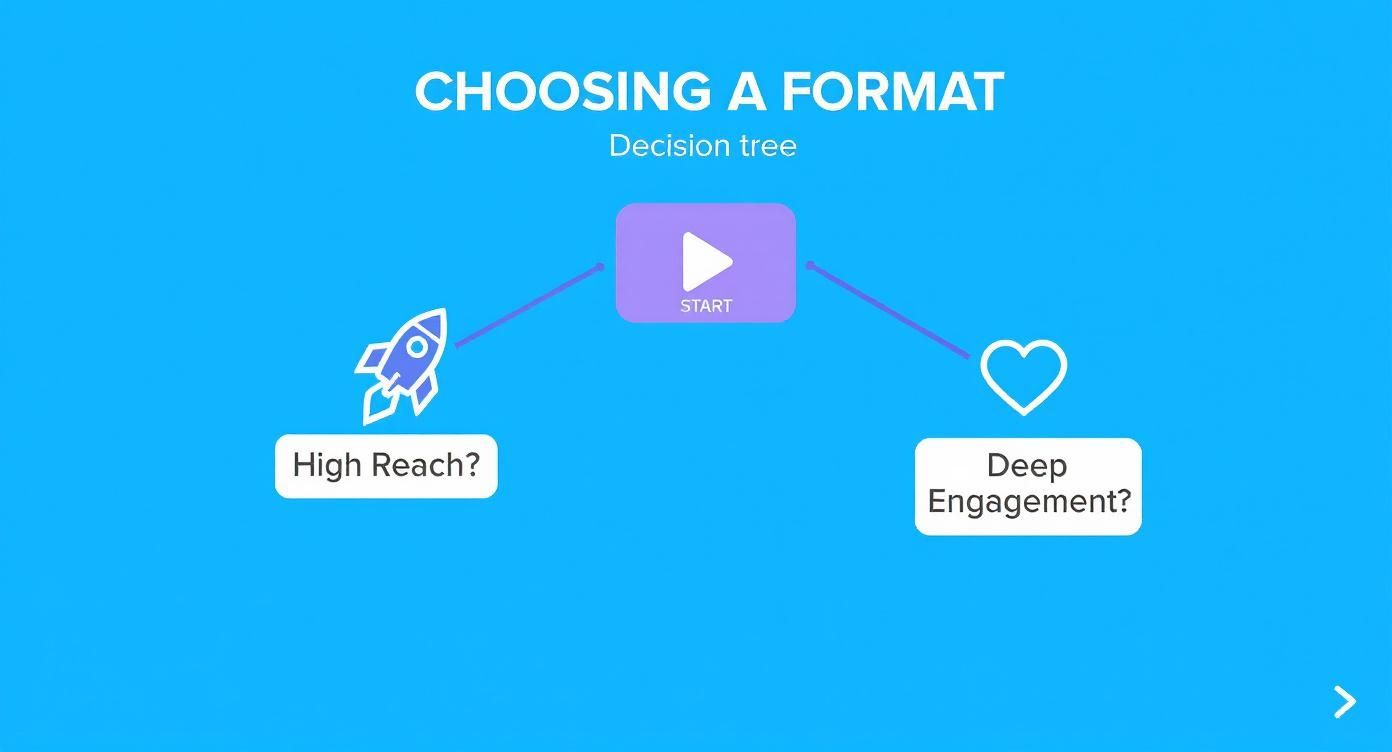Discover how to use video in carousel posts on Instagram and TikTok. Learn proven strategies to boost engagement, reach, and tell better stories.
In This Article
Subscribe to our newsletter
Putting a video in a carousel is one of the smartest plays you can make right now. It mashes up the scroll-stopping power of video with the deep-dive, self-paced nature of a swipeable post. This hybrid format creates a much richer, more interactive experience for your audience.
The result? People stick around longer, and social media algorithms love that.
Why Video in Carousels Is a Game Changer

For a long time, the conversation was always static images vs. carousels vs. standalone videos. Each one had its own lane. But when you mix them together, you get the best of all worlds, creating something that just clicks with how people browse feeds today.
It all comes down to user psychology. A video on that first slide is a dynamic hook that grabs attention way more effectively than a static image ever could. Once you've got them, the invitation to swipe turns them from a passive viewer into an active participant. That simple action can dramatically increase the time they spend looking at your content.
The Power of Hybrid Storytelling
Mixing your media lets you tell a much more compelling story. Let's say you're an e-commerce brand:
- Slide 1: A quick video showing your product in action.
- Slides 2-4: A few high-quality images that zoom in on key features.
- Slide 5: A clean graphic pulling a powerful customer testimonial.
This multi-format approach tells a far more complete story than any single format can on its own. It speaks to everyone—the people who respond to motion, those who pore over details, and the ones who need that final bit of social proof. To see how video carousels fit into the bigger picture, check out these 12 Types of Social Media Content to Master in 2025.
Carousel vs Reels Performance on Instagram
There's been a ton of buzz about Reels, but the data shows that carousels are quietly becoming a powerhouse for engagement. Here’s a quick look at why they’re getting so much attention from savvy marketers.
| Metric | Carousel Performance | Reels Performance |
|---|---|---|
| Reach | 13% higher than Reels | Solid, but often less consistent |
| Engagement Rate | 1.5 times higher than Reels | Highly variable; depends on trends |
| Interactions/Post | 51% more interactions on average | Lower average interactions |
The numbers are pretty clear. While Reels are fantastic for discovery and viral potential, carousels are currently leading the pack when it comes to driving deeper, more meaningful engagement with your existing audience. It’s a format that encourages people to slow down and interact.
This boost in engagement sends a huge signal to the algorithms. Platforms like Instagram are built to keep people on the app. The "swipe-and-watch" behavior that video carousels encourage directly feeds into those critical metrics, which can earn you a lot more organic visibility.
Choosing the Right Video for Your Carousel

This isn't about just grabbing your best-performing Reel and dropping it into a carousel. The video you choose has to serve a real purpose within the carousel's story. It should feel like a natural, essential part of the sequence, not some jarring commercial break.
Think of it as the hook that pulls people into the rest of your content. For an e-commerce brand, a quick 5-second product demo on the very first slide is a killer move. That flash of motion grabs their attention instantly, and the static images that follow can then dig into the details—close-ups, different colors, and pricing. The video doesn't need to do all the heavy lifting; it just needs to make them need to swipe.
Another smart play is for service-based businesses. Imagine you're a consultant. You could sandwich a short client testimonial video on slide two, right between your intro slide and the ones detailing your packages. It’s a perfect way to drop in some social proof exactly when a potential client is most curious.
Key Technical Considerations
To keep the experience smooth and professional, your video has to be optimized for the carousel format. A few small technical details can make a huge difference in how well your post performs.
- Video Length: Shorter is almost always better. You're aiming for the 3 to 15-second sweet spot. Anything longer, and you risk killing the swipe-through momentum you're trying to build. You want a quick, dynamic loop that adds value without feeling like a commitment.
- Aspect Ratio: This one’s a non-negotiable. Your video's aspect ratio absolutely must match your static images, whether that's a square (1:1) or a portrait (4:5). When the sizes are mismatched, it creates an ugly, jarring jump between slides that just screams amateur.
- File Format & Size: Stick to the basics here: .MP4 or .MOV are your best bets. Your main goal is to compress the file size as much as you can without turning it into a pixelated mess. A smaller file means it loads instantly, even for someone scrolling on a weak connection.
The best videos in carousels don't compete with the static images—they complement them. Think of the video as a dynamic accent that elevates the whole story and keeps people swiping.
At the end of the day, your choice of video has to tie directly back to the carousel's goal. Whether you're showing off a feature, building trust with a face-to-camera clip, or just adding an element of surprise, make sure that video is working for you.
Your First Video Carousel Post: Step-by-Step
Alright, let's get our hands dirty and actually build one of these. The biggest mistake I see people make is just grabbing a few random clips and photos from their camera roll and calling it a day. A great video in carousel post tells a story, and that requires a bit of planning.
Think of it like a mini-movie. Your first slide, with that scroll-stopping video, is your opening scene. It has one job: get someone to stop and swipe. This video sets the entire mood. So, before you even open the app, storyboard the whole thing. What’s the hook? What comes next? How does it all connect?
Once you have that map in your head, the technical part is easy. On Instagram, for example, you just hit the "select multiple" icon when creating a post. This lets you pull in both your videos and photos, and you can drag them around to get the order just right.
Getting That Polished, Professional Feel
The difference between an amateur-looking carousel and a professional one often comes down to one word: consistency. You want the jump from a moving video to a still image to feel smooth and intentional, not like a jarring mistake.
The easiest win here is a consistent color grade. Seriously. Applying the same filter or preset across every single slide instantly ties the whole package together.
- Consistent Color Grade: Slap the same filter on everything. It creates a unified, professional look that feels deliberate.
- Pick a Great Thumbnail: Don't let the app pick a random, blurry frame for your video cover. Choose a custom thumbnail that's clear, hints at the action, and practically begs to be tapped.
- Tell a Cohesive Story: Make sure each slide logically flows into the next. A video showing a product in action could lead to static images highlighting the specific features you just saw.
Think of the entire carousel as a single, immersive experience. The video is what reels them in, but the visual consistency is what keeps them swiping all the way to the end.
This is more than just a fancy post format; it's a powerful storytelling technique. Nailing these carousels is a huge part of mastering content creation on social media, where every post needs to work hard for you. When you focus on a clear narrative and a polished look, you turn a simple feature into one of your best engagement tools.
Why Algorithms Love Video Carousels
Let's get one thing straight: social media algorithms aren't playing favorites with formats just for fun. Their one and only goal is to keep people on the platform for as long as possible. A video in a carousel just happens to be a perfect tool for that job.
Think about it from the algorithm's perspective. When someone stops scrolling to watch a video on your first slide, that's a good signal. But when they also keep swiping to see the rest of your content? That’s a home run.
This simple act of watching and swiping lights up the two metrics that matter most: session duration (how long they stay on the app) and dwell time (how long they linger on your post). Both of these tell the algorithm your content is sticky, valuable, and deserves to be pushed out to a wider audience.
It’s All About the Interaction Signals
It’s not just about the time spent, either. Video carousels create a rich tapestry of interactions that a single video or image post just can't match. The swipe itself is a form of engagement, but the real magic happens when people swipe back and forth, re-watching a clip or re-reading a slide.
This kind of layered engagement is a goldmine for your visibility. For example, recent TikTok data revealed carousels pull in 2.9 times more comments and 2.6 times more shares than a standard video post. This isn't a coincidence; it's a direct result of the platform pushing a format that keeps users hooked. You can dig deeper into why this is a major trend for the coming year by checking out the latest insights on carousel performance in 2025.
The algorithm isn't just seeing a single "like." It's tracking a user watching, swiping, maybe swiping back to re-watch a video, and then swiping forward again. Each of those micro-actions is a distinct, positive signal that juices your content's quality score.
Ultimately, platforms are rewarding the behavior that video carousels naturally encourage. By using them, you're not just following a trend; you're strategically aligning your content with how these systems are built to measure value, giving your organic reach a serious boost.
Optimizing Carousels for Maximum Engagement
Putting together a sharp-looking video in carousel is a great first step, but the real magic happens when you start optimizing every little detail to get people to act.
Think of your caption as less of a description and more of the opening line in a conversation. It has to hook people instantly and give them a solid reason to care enough to swipe past that first slide. A good caption will often ask a question or hint at a solution that’s waiting in the slides to come.
So, instead of a flat "Here's our new process," try something with a little more intrigue: "We cut our workflow time in half. Swipe to see exactly how we did it." That subtle change reframes your content as a valuable secret, making the swipe almost automatic.
The Strategic CTA and Hashtag Mix
Your final slide is your most valuable piece of real estate—don't let it go to waste. This is your moment for a clear, direct call-to-action (CTA). You need to tell your audience exactly what you want them to do next. No guesswork.
- To boost engagement: "Which tip was your favorite? Drop a comment below!"
- To drive sales: "Ready to try it? Tap the link in our bio to shop the look."
- To build community: "Save this post for later and share it with someone who needs it!"
Once you have your content and CTA locked in, it's time to think about hashtags. A smart strategy uses a mix of broad, niche, and branded tags. This helps you show up in wider searches without getting totally lost in the noise, connecting you with both new faces and your core community.
A huge mistake I see all the time is treating every format the same. A Reel is a broadcast; you're trying to hit as many new people as possible. A carousel, especially with video, is a conversation. It's built to go deeper with the people who are already listening.
Carousels for Engagement vs. Reels for Reach
So, when should you use a carousel versus a Reel? It really just boils down to your main goal for that specific post. This little decision tree can help you figure it out.

This visual gets right to the heart of the strategic trade-off. If you're running a top-of-funnel campaign to get your brand in front of as many new eyes as possible, Reels are your best friend. But if you want to nurture the audience you already have and spark genuine interaction, the video carousel is hands-down the better tool for the job.
Instagram Format Performance Breakdown
The data backs this up. It's not just a feeling; there's a clear statistical difference in how these formats perform based on the objective.
| Format | Primary Strength | Average Reach | Average Engagement Rate |
|---|---|---|---|
| Reels | Mass Awareness | High | Lower |
| Carousels | Audience Nurturing | Lower | Higher |
Epic Owl’s 2025 analysis really drove this point home. They found that while Reels reach an average of 36% more users, carousels pull in about 12% more interactions (likes, comments, saves). This makes carousels the undeniable winner for building a loyal community. You can dive into the full Reels versus carousel performance on Epic Owl's blog to see all the details.
Ultimately, the choice is yours: do you want to shout to a crowd or have a meaningful conversation with your community? Your answer will tell you which format to use.
Your Top Video in Carousel Questions, Answered
As the video in carousel format really starts to take off, a lot of practical questions are bubbling up. I hear them all the time. People wonder about everything from where to place the video to the technical nitty-gritty.
Getting these details right is what separates a carousel that gets ignored from one that people can't stop swiping. Let’s clear up some of the most common points of confusion.
Should the Video Always Be the First Slide?
Putting your video on the very first slide is a fantastic way to stop someone mid-scroll. In a crowded feed, that initial flicker of motion is like a magnet for the eyes. If your main goal is to grab attention immediately, this is almost always your best bet.
But it’s not the only way to play it. I've seen some really clever carousels build anticipation with a couple of strong static images first. Then, boom—the video hits on slide three as a surprise or a deep dive. This works wonders if you're telling a story that needs a little setup before the main event.
Can I Use Multiple Videos in One Carousel?
You absolutely can. Both Instagram and TikTok fully support multiple videos in a single carousel, often mixed right in with your static images. This opens up a whole new world of creative storytelling.
I’ve found this works especially well for a few specific scenarios:
- How-Tos: Break down each step of a process into its own quick video clip.
- Before-and-Afters: Nothing shows a transformation better than two distinct videos.
- Product Demos: Show off different features, angles, or uses of a single item.
The trick is to keep each video clip short and punchy. You want to keep that swiping momentum going, not grind it to a halt with a long video. Each clip needs to add a new piece to the puzzle.
The best multi-video carousels treat each clip like a chapter in a short story. Every slide should feel satisfying on its own but also make you desperate to see what’s next.
What’s the Sweet Spot for Video Length?
Short and sweet wins the race here. For a video inside a carousel, you’re aiming for a length between 3 to 15 seconds. Any longer than that, and you're just begging people to get bored and swipe away before they see the rest of your content.
Remember, the video's job is to be a dynamic part of a larger story, not a standalone movie. Think of it like a high-quality GIF—a short, looping clip that adds perpetual motion without breaking the flow of the swipe. A long video is the fastest way to make sure no one ever reaches your final call-to-action slide.
Ready to create stunning, high-impact videos for your carousels and beyond without all the heavy lifting? Aeon uses AI to transform your existing content into engaging videos at scale. See how publishers are boosting engagement by visiting our website.


.jpg)